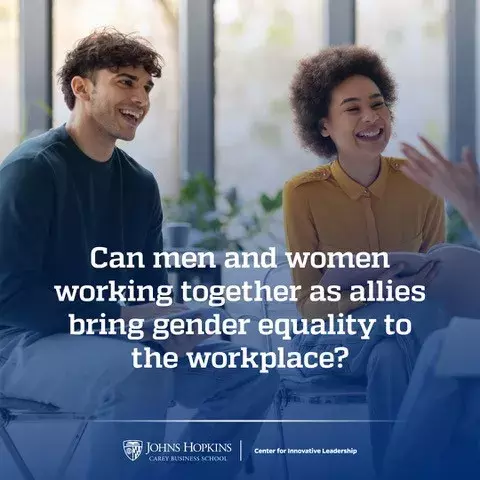Gender equity is an organization-wide leadership issue best addressed by men and women working together as allies to the cause.

Allyship for Gender Equity at Work
Summary
Failure to fully engage female talent in the workplace particularly in leadership roles is not only unfair on the individual and a waste of talent, it also has a detrimental effect on economic performance. Despite progress being made since the days of 1970s feminism, the private and public sectors are both far from achieving gender equality.
To improve the prospects of female employees organizations tend to see this as a challenge for the HR department. Various compliance initiatives are tried—unconscious bias training, sexual harassment awareness training—but these are often ‘tick-box’ exercises with few positive results, and some negative ones.
A recent study offers a different approach, proposing that men as allies to women are the missing ingredient in achieving gender equity, that diversity and inclusivity is a leadership issue at all levels, and that organizations should cultivate workplace cultures that value and encourage allyship behaviors intentionally aimed at fostering gender equality.
From 1970, the year Germaine Greer’s Female Eunuch was published, until 2000, significant advances were made towards gender equity in the workplace. Unfortunately, over the past two decades progress—as measured by employment numbers, pay equality, and representation in senior decision-making roles—has slowed (a trend made worse during the COVID-19 pandemic), and many of the challenges women have traditionally faced when seeking career advancement remain.
At senior board level, in publicly quoted companies, the target set by the 30% Club in 2010 has nearly been achieved in the US and slightly exceeded in the UK—but this is far from universal. In Brazil and Japan only around 12% of board members are women. Furthermore, the progress made at board level in high profile public companies masks the poorer situation in smaller private companies and at management levels below the board.
The general level of female employment, which has declined in recent years, and the gender pay gap are further causes for concern. This is despite female educational achievement reaching a peak, with women regularly surpassing men in the proportion of first and post-graduate degrees. The waste of talent this represents is especially unacceptable today when there are severe skills shortages in many industries across the developed world.
“Gender equality has stalled and will take another 257 years to achieve at the current pace of progress,” asserts Dr. David Smith, an Associate Professor at the Johns Hopkins Carey Business School, the author of a recent study that looks at the underlying causes of gender inequality and suggests ways to kickstart progress.
Causes of gender inequality
Prejudice and even misogyny are prevalent at times, but larger societal causes are the main barriers to gender equity at work. The unequal division of household labor experienced in past generations has largely disappeared for dual-income couples without children, but lives on for parents. Mothers typically take on the brunt of childcare adding more than two hours per day to their domestic workload while men add 40 minutes.
The segregation of occupational roles by gender is a longstanding source of workplace inequality. As more women have joined male-dominated professions things have gradually improved but it is a sporadic picture. 40% of all lawyers in the US are women, in the UK it is 52%, but in the tech sector only 26% of employees and 11% of managers are women, in both countries. Segregation is caused both from the employer side—due to ingrained professional, and organizational influences—and from the employee side as women’s aspirations are influenced by socio-cultural expectations.
Leading towards gender equity
Bearing in mind these cultural and institutional influences on gender inequality, efforts to drive progress in the workplace need intentional leadership. Rather than seeing this as a ‘women’s issue’ and off-loading it to the HR department to come up with new initiatives, leaders at all levels must take an active role in promoting equality. Women have made great strides in creating career opportunities for themselves, it is now important that men play their part as leaders and allies in partnering with women to further the cause.
For the obvious reason that men are still more likely than women to occupy positions of influence and power at work, men are well placed to be part of the solution. This is particularly the case because men, showing support for women’s aspirations, are not perceived to be acting based on self-interest. When men confront other men for biased behavior or sexist language they are not penalized. On the other hand, many men overestimate their male peers’ acceptance of sexism which can inhibit their motivation to confront others. Men speaking up for women has the knock-on effect of giving women themselves more confidence to confront inequality. Ultimately all benefit as organizations with equitable cultures and higher levels of psychological safety perform better and have lower employee turnover.
Men who would be allies
Male allyship is defined as “actively promoting gender fairness and equity in the workplace through supportive and collaborative personal relationships and public acts of sponsorship and advocacy intended to drive systemic improvements to the workplace culture.” Men who would be true allies to women colleagues need to adopt three distinct standpoints:
- Interpersonal. Holding themselves individually accountable for how they show up in the workplace and the types of relationships they have with their female bosses, peers, and employees.
- Accountability. Ensuring accountability for behavior from team members and leaders while publicly advocating for women.
- Organizationally. Demanding organizational accountability in everyday systemic practices, and proactive policies for eliminating gender bias.
There are three good reasons why men would want to take on these roles, even in male-dominated environments. First, they will have personal connections with women they will want to support. Secondly, because they understand the business case. A diverse and gender-balanced workforce can mean more creativity, improved decision-making, and better performance—or more cynically because being seen to do the right thing is good for their personal brand. Thirdly, through pure altruism—a better, fairer world for all and especially for their children.
Barriers to allyship
In the developed world, in the 21st century, most men believe in gender equality and are aware of the many personal and professional benefits associated with allyship, and yet progress towards gender equality has been disappointingly slow.
While some men perceive women’s advancement as a threat, a more common barrier to gender equity comes from outdated perceptions. False narratives about women, such as that they are not strong leadership material, that they are overly focused on nurturing and caregiving, or conversely that they are ‘bossy’ when given authority. There is also the anxiety some men have about forming non-sexual close relationships with women at work—recently exacerbated as an unintended consequence of the #MeToo movement.
For women, the chivalrous protective behavior sometimes shown by men can be undermining and disempowering. In some cases, men who believe in gender equality think and say that they are doing something about it when in fact they are doing very little. This can be due to a lack of full awareness of the problem, or a lack of feedback, or to uncertainty about what practical action they should be taking.
Developing an allyship culture
Diversity and inclusivity at work are much talked about, yet are too often seen as exclusively HR department issues to be solved by some compliance initiative or other. This is a mistake as it sends the message to frontline managers that they have no role or accountability in this area. These are fundamental leadership issues relevant at all levels of the organization. When it comes to gender equity specifically, it is important that organizations cultivate workplace cultures that encourage allyship between men and women intentionally aimed at fostering women’s advancement.
Creating allyship is about training and education particularly at the senior leadership level. It is also about communicating why gender equity benefits both sexes, and about motivating managers to see the advancement of women as part of their responsibility, regardless of their function or business unit. Allyship also has a place on the home front. By sharing domestic duties equably, men can greatly benefit their female partners’ career prospects, and men in organizational leadership roles can help by supporting moves to flexible working practices.
Finally, the most visible allyship should come from the C-suite. Senior board members should be accountable for making internal process and structural changes necessary to eliminate systemic inequities such as the gender pay gap and the lack of women’s representation in senior leadership. Through transparency and clear communication, the board should ensure their suppliers and other stakeholders are aware of their attitude to and actions to support gender equality. Not only is this the morally right thing to do, it is ultimately good for the brand and the bottom-line.
The Center for Innovative Leadership (CIL) at the Carey Business School aims to advance knowledge and build capacity for innovative leadership in modern organizations. CIL is a hub for new ideas and insights on leadership, combining faculty-led research, student-facing programming, and community-focused impact.


